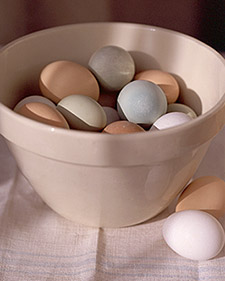 Judging Freshness: To test a raw egg's freshness, place the egg in a bowl of water. If it sinks, it's fresh; if it floats, it is filled with too much air and has gone bad. Also, discard any eggs with any blood spots; these indicate that the hen that produced them was sick.
Judging Freshness: To test a raw egg's freshness, place the egg in a bowl of water. If it sinks, it's fresh; if it floats, it is filled with too much air and has gone bad. Also, discard any eggs with any blood spots; these indicate that the hen that produced them was sick.Storing Eggs: It is best to store the eggs in the carton they come in, rather than transferring them to the plastic egg holders often found on refrigerator doors, where they will be subject to frequent temperature fluctuations as the door opens and closes.
Boiled Eggs
Despite the name, boiled eggs should not be boiled throughout the cooking process -- a method that yields a rubbery result -- but instead should be brought to a boil and then removed from the heat.
Instructions:
Place eggs in a single layer in a saucepan, and cover with 1 inch of cold water. Bring to a boil, cover, and immediately remove from heat. Let stand approximately 1 1/2 to 2 minutes for soft-boiled, 2 to 2 1/2 minutes for medium-boiled, and 12 to 13 minutes for hard-boiled. Remove eggs from water.Soft- and medium-boiled eggs should be served immediately in egg cups -- perfect for cracking and scooping the egg right from the shell.
Hard-boiled eggs should be removed from the pot and plunged into a bowl of ice water. This prevents the yolk from discoloring due to overcooking and facilitates peeling. Let stand for 2 minutes, then crack by gently pressing the egg against a hard surface. Peel under cold running water. Serve.Scrambled Eggs
The key to fluffy scrambled eggs is to beat the eggs briskly for at least 15 seconds before cooking, incorporating air to produce large, puffy curds.
Instructions:
In a medium bowl, beat eggs (2 per serving) vigorously for at least 15 seconds. In a medium nonstick skillet over medium-high heat, melt 2 teaspoons butter. When the butter is melted and foamy, add eggs. Reduce heat to medium, and using a spatula or flat wooden spoon, push the cooked eggs toward the center while tilting the pan to distribute the runny parts. When the eggs are almost set, scramble them gently, turning them over a few times. Serve immediately.
Fried Eggs
Break the eggs into a bowl before sliding into the skillet to prevent the yolks from breaking. When a fresh egg is added to a hot skillet, the thick white of the albumen clings to the yolks. To ensure that the egg white is set throughout, gently break the sac with the tip of a spatula to distribute the white evenly.
Instructions:
Heat a medium nonstick skillet over high heat. Break eggs (2 per serving) into a small bowl. When butter is melted, carefully slide eggs into pan, holding the bowl as close to the pan as possible to prevent breaking yolks. Reduce heat to medium, and gently poke egg-white sac to release whites, tilting the pan to distribute them. Cook until whites are set, about 1 minute. (For eggs over easy: After whites are set, carefully turn eggs over with a spatula. Cook 30 seconds on other side). Serve immediately.
Poached Eggs
Always use the freshest eggs you can find for poaching: The thick albumen will hold its shape better around the yolk than older eggs. Add vinegar to the poaching water to help the eggs coagulate faster by preventing the whites from spreading out.
Instructions:
Bring a large, wide saucepan of water and 1 tablespoon of vinegar (any flavor) to a boil. Break one egg at a time into a small heatproof bowl, about the size of one egg. Reduce heat so that the water is just simmering. Slightly immerse the bowl in the water, and gently slide in the egg. After all eggs are added, cover pot, turn off heat, and let stand 2 to 3 minutes. Using a slotted spoon, remove eggs in the order they were added and set spoon briefly on a kitchen towel to drain. Trim ragged edges with a knife or scissors, if desired, and serve immediately.

No comments:
Post a Comment